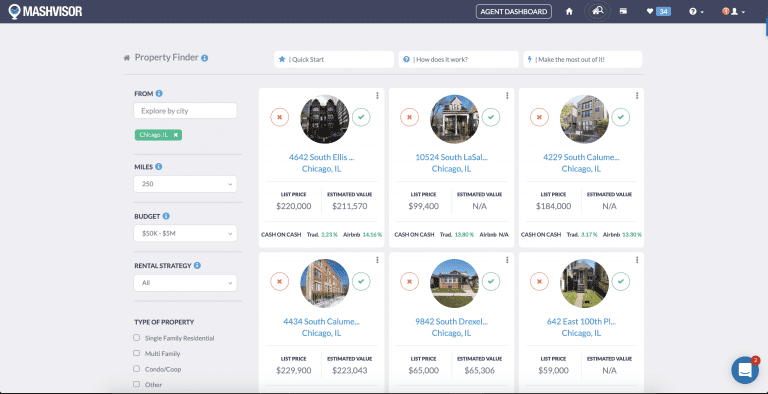Real estate investing relies on a plethora of metrics and indicators. These figures are crucial when it comes to assessing the profitability of a real estate investment as well as its ability to generate consistent cash flow over the long haul. One such important metric is cash on cash yield. As the name suggests, this is an estimation of the rate of return relative to the amount of cash that you invest in a property. Needless to say, this measure is an integral part of real estate investment analysis. So how to calculate cash on cash yield? And what is a good cash on cash yield in real estate? Keep reading as we break down every aspect of this important metric.
The Cash on Cash Yield Formula
The formula for the CoC yield is fairly simple. In fact, it only uses two variables: pre-tax cash flow and the total cash invested in the income property.
Cash on Cash Yield = Pre-Tax Cash Flow / Total Cash Investment
Determining pre-tax cash flow involves calculating several other variables. The easiest approach is to simply subtract operating expenses, vacancy, and mortgage payments from the total income that the investment property generates. Let’s take a look at an example that illustrates how to calculate cash on cash yield for residential real estate.
Example
Let’s assume that you acquired an investment property for $500,000. Your down payment was $50,000 and the rest was borrowed from a bank. There are also repair costs that amount to around $8000. The property generates a yearly total income of $25,000 and after one year, you made mortgage payments totaling $15,000. Here is the cash on cash yield that you can expect out of this investment.
Property Cash Flow = 25,000 – 15,000 = 10,000
Your Cash Investment = 50,000 + 8,000 + 15,000 = 73,000
Cash on Cash Yield = 10,000/73,000 = 13.6%
An easy way to calculate cash on cash yield is to simply use the Investment Property Calculator. This high-end tool allows you to calculate a host of valuable metrics such as cap rate, cash flow, and cash on cash return. Additionally, Mashvisor’s calculator offers you a number of extra features such as neighborhood analysis and optimal rental strategy recommendation.
Understanding the Implications of CoC Yield
Learning how to calculate cash on cash yield is only the first step towards incorporating it into your investment property analysis. You still need to grasp its significance when it comes to assessing a particular investment. The cash on cash return is at its most effective when analyzing acquisitions that involve long-term debt. Unlike the standard return on investment rate, the fact that this metric takes debt into consideration enables it to yield accurate results that reflect the reality of the investment. Having said that, the cash on cash yield does have some limitations. The most obvious one being the exclusion of taxes from the formula.
What Is a Good Cash on Cash Yield Real Estate Rate?

Figuring out the ideal cash on cash yield depends on a wide array of factors. While most real estate investors consider the 8% to 12% range to be ideal, there is no set rule. More importantly, what constitutes a good yield for a beginner might not be up to the standards of an experienced investor. In fact, some real estate investments that only guarantee a 3% yield can be perfectly suited to novice investors. The ideal cash on cash yield is ultimately a matter of your own expectations as well as your level of experience in the real estate market.
Another important factor to keep in mind is the type of housing market you’re investing in. For example, a high appreciation market might yield low rates, but that does not negate the huge potential that the investment property will offer you in the long run.
How to Find Investment Properties with Good Cash on Cash Yield
Now that you are familiar with the concept of cash on cash yield, the next logical step is to find properties that have your desired rate. At the end of the day, making money from rental properties is only possible if you can get a decent return on your cash investment. In any event, here are a few effective ways to identify properties with high cash on cash yield.
1- Focus on real estate markets with good long-term indicators
The key to finding good cash on cash yield is narrowing the search down to real estate markets that still have room to grow. Examples of indicators to focus on include population growth rate, the health of the job market, size of the tourism sector, and overall economic prospects of the city. As for specific markets that meet these criteria, cities like Pittsburgh, PA and Palm Springs, CA are ideal for long-term rental strategies. For Airbnb, Memphis, TN, and Fort Wayne, IN are worth a serious consideration.
2- Use the Mashvisor Property Finder
Using advanced tools is by far the most convenient way to find profitable real estate investments. The tools that Mashvisor puts at your disposable are especially effective in zeroing-in on income properties with good metrics. Using the Property Finder will allow you to streamline the search process and identify properties that fit your preferences in a matter of minutes. Furthermore, the tool provides you with a list of properties for sale with the highest cash on cash yields in a given location. This will save you the hassle of manually comparing and analyzing multiple search results.
Do you have a free Mashvisor account? Use our Property Finder to find lucrative investment properties that match your criteria in a matter of minutes!
The Bottom Line
The simplicity of cash on cash yield has made it the go-to metric for assessing the potential returns that you can expect from a cash investment. With that being said, relying on it exclusively is not recommended. Investment property analysis is a multifaceted process that involves several variables. Making a smart investment decision is, therefore, predicated on taking all of them into consideration. To learn more about how you can analyze properties in a quick and effective manner, check out our blog.
